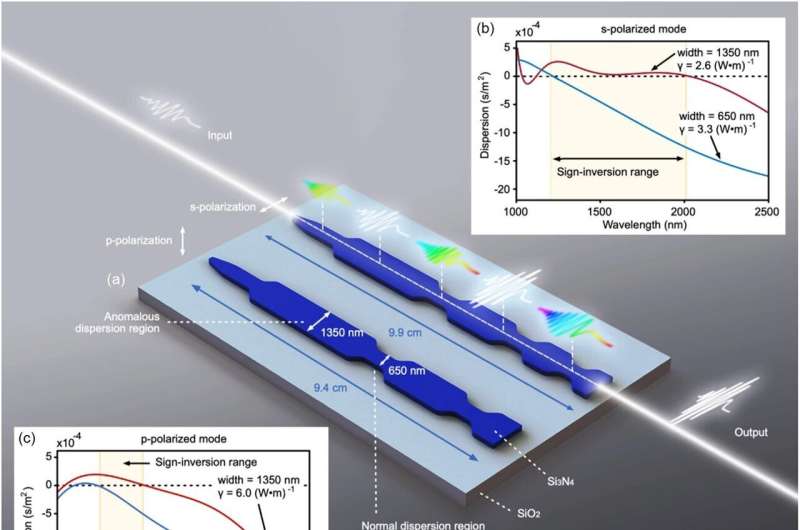Sign-alternated-dispersion silicon nitride waveguides for efficient SCG. a) An illustration of integrated waveguide structure 1 and structure 2. The darker region indicates the silicon nitride core, while the lighter region corresponds to the silicon oxide cladding. The overall lengths of both structures are indicated, and the amounts of ND and AD segments are also shown. Nonlinear pulse propagation is shown through the qualitative dynamics of the illustrated electric field profiles. The length and width of the segments are not shown to scale. For the exact geometrical dimensions of the waveguides, refer to Supporting Information I. b) Calculated dispersion profiles of the s-polarized mode versus wavelength for the AD segment of 1350 nm width (shown in red) and the ND segment of 650 nm width (shown in blue). The associated nonlinear coefficients of the waveguides are indicated as well. The shaded region is the wavelength range where the sign of dispersion is inverted. c) Dispersion profiles for p-polarizations, analogous to panel (b). d) Illustration of the experimental setup. A fiber laser delivering ultrashort pulses was used as the source. PBS refers to polarization beam splitter, DM refers to dielectric mirror (1550 nm), SM to broadband silver mirror, and MM refers to multi-mode fiber. Optical spectrum analyzer (OSA) refers to near-infrared or visible range optical spectrum analyzers (Ocean View NirQuest256 and Ando AQ6315A spectrum analyzer). Credit: Advanced Photonics Research (2023). DOI: 10.1002/adpr.202200296
A team of researchers from the University of Twente has made a breakthrough in ultraefficient on-chip supercontinuum generation. The findings, published in the journal Advanced Photonics Research, represent a major step forward in the field of integrated photonics and enable applications in portable medical imaging devices, chemical sensing and LiDAR.
Lasers normally emit light that is coherent: the waves they emit are identical in frequency and waveform. The coherent light makes it possible to send a narrow beam over extreme distances with very low noise. But this also means that lasers only emit a single color of light. This limits their applications.
In contrast, supercontinuum lasers are able to produce a continuous spectrum of color and can therefore appear white. They are used in 3D imaging devices. However, it turns out that to generate this wide bandwidth of colors, supercontinuum lasers have a high peak power consumption (pulse energy), are enormous and have to be stabilized in a laboratory. This makes them expensive and less useful than initially expected.
Alternating waveguides
The researchers from the University of Twente managed to significantly reduce this pulse energy needed. To do this, the team used so-called sign-alternating-dispersion waveguides. The waveguides are designed to control the dispersion of light by alternately widening and narrowing the beam of light.
"With this method, we reduced the amount of pulse energy needed around a thousandfold compared to traditional methods," says first-author Haider Zia, "This is an exciting development in the field of integrated photonics. Our method offers a more efficient way to generate supercontinuum light on a chip, which has many potential applications in medical imaging and LiDAR."
More information: Haider Zia et al, Ultraefficient on‐Chip Supercontinuum Generation from Sign‐Alternating‐Dispersion Waveguides, Advanced Photonics Research (2023). DOI: 10.1002/adpr.202200296
Provided by University of Twente
























